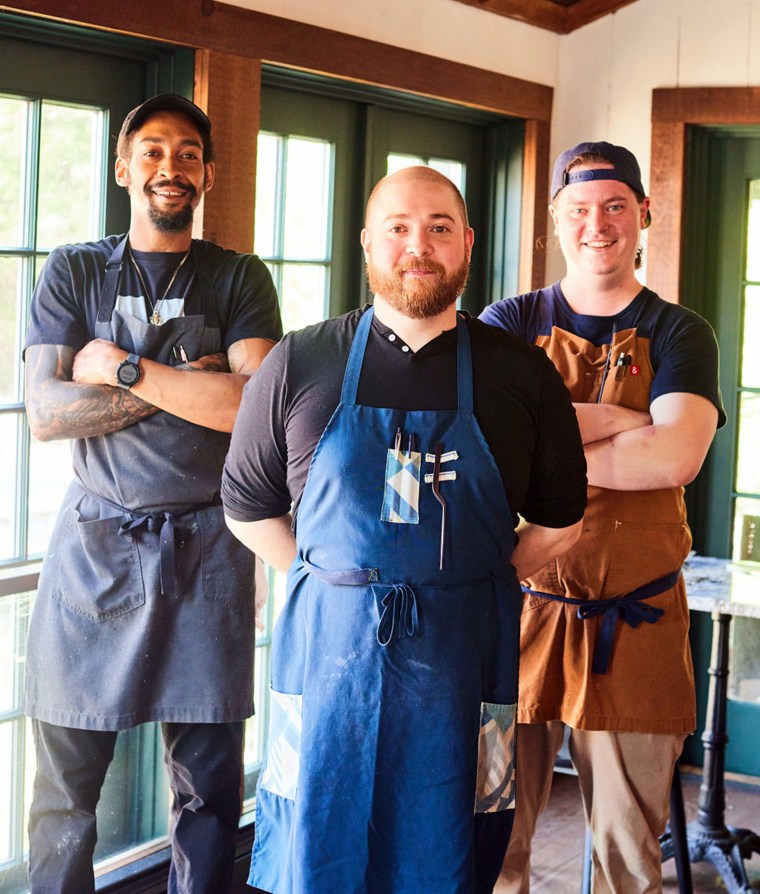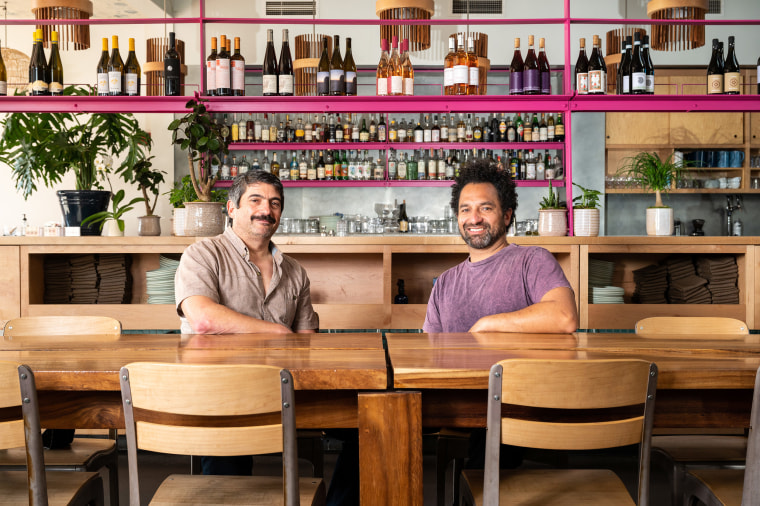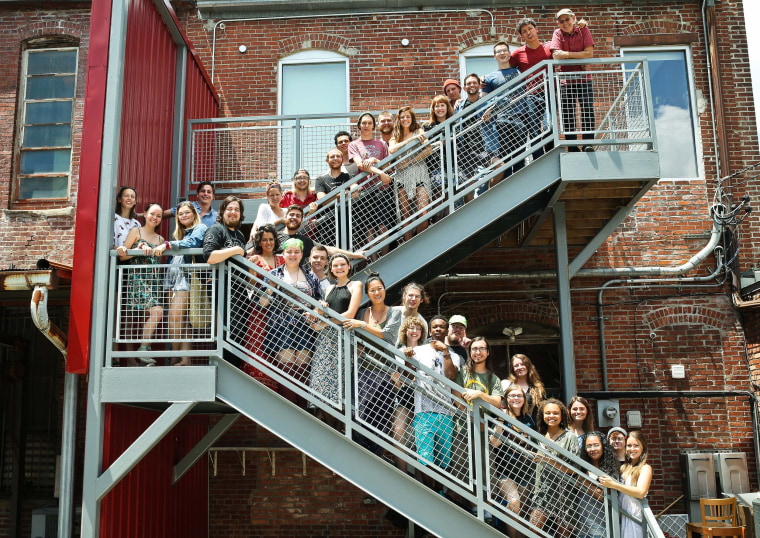Dear Mister Manners: Ever since the pandemic began to wane, I’ve been noticing restaurants sneaking surcharges onto meal tabs. Where does this money go? And am I still expected to give a gratuity when I’m being compelled to pay for things such as “kitchen wellness”?
(Mealtime with Mister Manners is a weekly column that delves into a smorgasbord of dining-etiquette dilemmas. Please submit your questions at the bottom of this page.)
Faced with a tight labor market and high turnover, restaurateurs across the U.S. are taking a fresh look at ensuring the well-being of their staffs. For some, that has included rolling out surcharges to fund employee benefit programs. For others, it can be a way of balancing the scales for those who work in the kitchen — a group that is not tipped and whose take-home pay often leaves them struggling to afford basic living expenses.
“A dish washer working 40 hours for minimum wage in New York will earn less than $600 a week,” said David Schneider, a restaurateur in the state's Upper Hudson Valley. “By contrast, a server in the same hypothetical restaurant could be making $1,100 in tips and wages for far fewer hours. The bartender might be pulling in $400 a night.”

With this inequity in mind, when he and his wife, Patty Wu, opened their eatery, Tabla, in late 2021, they unveiled an idea that was hardly conventional: an 18% “living wage” surcharge included on every tab. The amount went directly to employees — 10% to the kitchen staff and 8% to the servers. As the living wage fee did not replace the traditional gratuity, many customers were confused. A good number balked, wondering why they were being asked to "tip twice."
And though the back of house staff may have been pleased, his servers were less so. They immediately started seeing their own earnings go down as restaurant patrons trimmed their discretionary tips. Tweaking the model to address those concerns, Schneider ultimately lowered the living wage surcharge to 10%, all of which now goes to his non-tipped staff. Gratuities resumed their happy place of 18-20% for the servers, and all but a few patrons seemed to accept the add-on charge as a fact of life.
“Currently it’s working,” he said. “We can pay back of house a living wage and the front of house is happy.”
Challenging times
“The past two years have been difficult in the hospitality business,” said Troy Reding, co-owner of Ally Restaurants, whose Minnesota establishments include the Rock Elm Tavern in Plymouth and Rock Elm at the Grove in Maple Grove.
“It’s been more trying and more difficult than it was during the height of the pandemic,” he reported. Operating in the North Star State, where unemployment has been hovering around 2%, he has struggled to find talent. Once they’re hired, keeping them — and keeping them happy — is another feat. Treating staff as something other than worker bees has been one effective means of doing so.
In an industry not known for its benefits, the forward-thinking Reding first instituted a “wellness fee” in 2019. A 3% surcharge, this modest addition to patrons’ checks is put toward workers’ insurance premiums, paid time off, mental health access and even IRA contributions.
Although he’s faced pushback from some customers, most accept and understand it. “I think when you use a fee for a specific reason and it is to the benefit of your employees, that’s the differentiator,” he attested.
Commonplace in California
For gourmands in the Golden State, such surcharges are ubiquitous. In San Francisco, for example, where a local law mandates companies with more than 20 employees contribute to the health-insurance costs of their staffs, line items of 2-10% are common on restaurant checks.
At Good Good Culture Club, in the Mission District, discretionary tips are gone entirely, replaced by an across-the-board 20% “equitable compensation” fee. Co-owner Jeff Hanak said, “We do not accept gratuities. There is no separate line for them.” Though that policy may make superstar restaurant servers shudder, the staff at Good Good is paid a decent wage — anywhere from $28-35 an hour. Combined with the equitable compensation concept and a further 5% surcharge to fund the aforementioned city-mandated health insurance assistance, the restaurant is putting larger sums toward employee pay and benefits than it otherwise could.

Proclaims the Good Good website, “There have been inequities and imbalances baked into restaurant pay scales for far too long. We are looking to disrupt this archaic system and build a better one.”
Since he built his staff from scratch with the no-tipping policy already developed, Hanak has been able to fully communicate the restaurant’s core values during candidate job interviews. “This model is not for everyone,” he said. “But we are trying to eliminate barriers and are hiring staff members who genuinely want to take care of people.”
A sampling of patrons, he said, were a bit less enamored with the idea — whether because they resented being told how much to tip or perhaps even because they wanted to tip more than 20% and were being prevented from doing so. Sentiment appreciated, said Hanak, but, “for us, a thank-you and your return business would be much more welcome.”
Nationwide trend
Peter Dougherty, general manager of hospitality at Lightspeed, a company that creates software solutions for restaurants, began to see the surcharge trend really take off a year ago: “Starting in summer 2021, when the industry began to come back across the country, suddenly, all these restaurants had to rehire staff. They had to be competitive while at the same time costs for food and fuel were going up.”
In a 6,000-restaurant sampling of clients who use the Lightspeed platform, the company has witnessed a 36% year-over-year increase in the number that have surcharges on their checks. The Montreal-based corporation, whose products assist restaurants with everything from taking reservations to relaying food orders, is seeing line items pop up everywhere. And yet, somewhat surprisingly, food prices remained constant.

“Just as an example, the price for the burger, the pizza, has not gone up with the pace of inflation. What some restaurants have done to stay competitive — rather than having their margins compressed — they're adding these fees versus increasing the price of their menu items,” said Dougherty.
Why not just raise prices?
Dougherty’s observation is not lost on customers — nor on the owners of the restaurants they frequent. “Once you decide you’re going to charge $30 for a hamburger, a price that includes a built-in fee, you are never lowering the price of that burger,” said Schneider. And that’s not fair. If my beef cost comes down, my hamburger cost should come down.”
“When you have a wellness fee and you’re upfront about it, you are being more transparent than simply hiding it in your prices,” said Reding. But he sees the slippery slope, too. If restaurant checks start to become more difficult to decipher than a cellphone bill, he remarked with just the slightest amount of hyperbole, the industry will have gone too far.
Communication is crucial
Across the board, restaurateurs concur that changing the way patrons view surcharges begins with good and prominent messaging.
The Oregon Restaurant & Lodging Association has guidelines for its members that recommend noting surcharges not just on menus but also at the establishment’s entryway and website, among other locations. These descriptors should be unmissable, thanks to a larger point size, a contrasting font or other typographic means, the consortium advises.
Giving thanks, sans surcharge
For as many eateries as have adopted fees, for now at least, the practice remains the exception rather than the rule — even at places that pride themselves on thinking holistically.
A Kansas City restaurant Café Gratitude, whose free-spirited ethos is apparent to all who pass through its doors, has not yet gone the surcharge route. “We don’t want to do it if we can avoid it,” said Song Keller, the restaurant’s general manager. “Everyone is struggling right now. Yes, our employees … yes, our customers.”

Thanks to the success the restaurant enjoyed prior to the pandemic and the sustaining lifeline of PPP loans, Café Gratitude has been able to look after its team sans pass-along fees. Thankful that her customer’s tax dollars contributed to the PPP funds the cafe received, Keller is hopeful she won’t need to “add more financial burden for anyone during this difficult time.”
And though the restaurant, hard-hit by inflationary pressures and post-pandemic challenges, is presently operating in the red, she attested: "The point for us is not to make as much money as possible but to fulfill our mission, which is that love is served."

The new reality
At a time when increased wages for many Americans are being drawn out of their savings accounts as though being pulled through an open airlock, we are all more mindful of our spending. With that said, dining in a sit-down restaurant — regardless of whether it has adopted a surcharge — is a discretionary choice.
For an industry that made sure we were fed even when the pandemic was at its apex, putting their own members at willing peril, I for one will be paying surcharges willingly and happily. And as long as the option still exists, tipping just as gratefully as before.
Submit your dining etiquette questions here:



